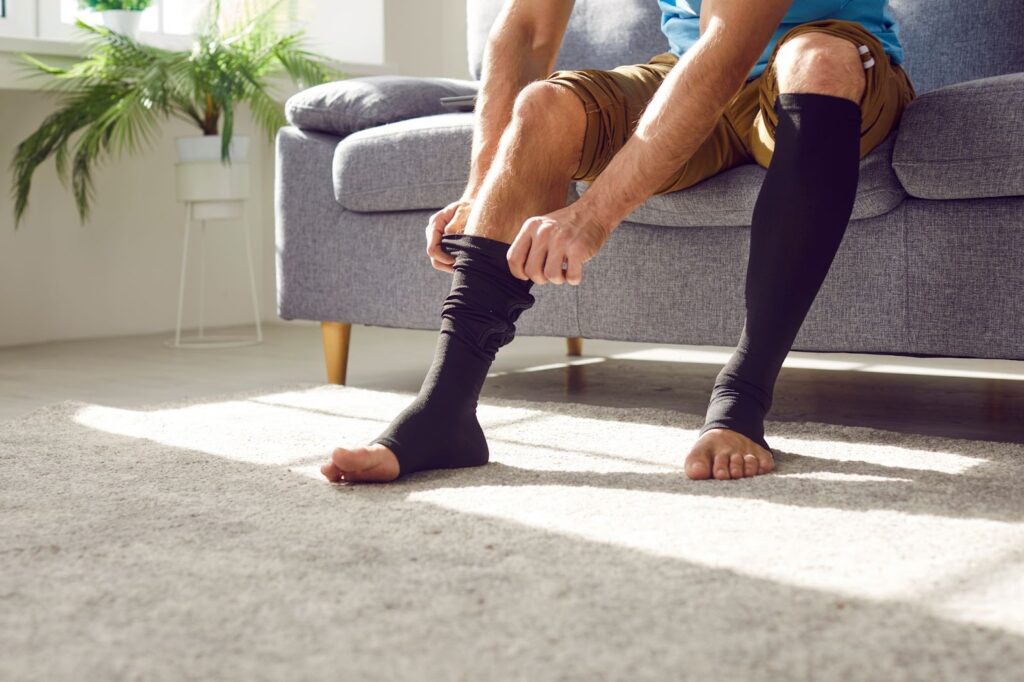Knee pain can be a debilitating condition that affects millions of people worldwide, from athletes to office workers to seniors spending their golden years enjoying a senior living community. Recent years have seen a surge in the popularity of compression socks as a non-invasive solution for alleviating various health concerns, including knee pain.
Compression socks may help seniors with knee pain. But they are not a one-size-fits-all answer and are typically part of a well-rounded treatment plan. Seniors should consult with their healthcare provider before trying any new treatments to ensure they’re not at risk for complications.
Types of Knee Pain: Acute vs. Chronic
Knee pain usually falls into two primary categories: acute and chronic.
Acute knee pain often results from sudden injuries such as sprains, fractures, or ligament tears. Treatment for acute knee pain varies depending on the cause, but it’s often treatable, and the individual can typically return to regular activity without pain after it’s healed.
On the other hand, chronic knee pain typically develops over time and is usually related to conditions like arthritis or prolonged wear and tear. Chronic knee pain can’t always be completely cured or reversed, so symptom management becomes crucial.
Common Causes of Knee Pain
Understanding the root cause of knee pain is crucial for effective treatment. Some common causes include:
- Osteoarthritis: The wear and tear of cartilage around the knee joint.
- Rheumatoid arthritis: An autoimmune condition causing inflammation and pain.
- Patellar tendinitis: Inflammation of the tendon connecting the kneecap to the shinbone.
- Meniscus tears: Damage to the cartilage that cushions the knee joint.
The Impact of Knee Pain on Daily Activities
Knee pain can severely limit your ability to perform daily activities. Simple tasks like walking, climbing stairs, or even sitting for extended periods can become excruciatingly painful. This can lead to decreased quality of life, limited mobility, and less independence. This could be a significant challenge for a senior who may already be having some minor mobility issues
What Are Compression Socks?
Compression socks are specialized socks that apply gentle pressure to your legs and feet. They’re made from elastic materials that fit snugly, enhancing blood flow and reducing swelling. Compression socks also come in varying lengths and tightness.
How Do They Work to Alleviate Knee Pain?
Compression socks work by improving circulation and reducing inflammation around the knee joint. The graduated pressure helps reduce fluid buildup and swelling, which can alleviate pain and improve mobility. Enhanced blood flow also aids in quicker recovery from injuries.
Who Can Benefit from Compression Socks?
Compression socks can be particularly beneficial for older adults dealing with arthritis, osteoarthritis, patellar tendinitis, and even those recovering from knee surgery. Runners and athletes also find them useful for reducing muscle fatigue and speeding up recovery.
How to Choose the Right Compression Level & Size
Selecting the appropriate compression level and size is crucial for effectiveness. Compression levels are measured in millimeters of mercury (mmHg). A lower compression level (15-20 mmHg) is often sufficient for mild knee pain. Higher levels (20-30 mmHg) may be needed for more severe conditions.
Always consult a healthcare professional to determine the right fit and compression level for your needs.

Using Compression Socks
Wearing compression socks correctly is essential for maximum benefit. Start by rolling the sock down to the heel, then slide your foot in. Gradually unroll the sock up your leg, ensuring it’s smooth and wrinkle-free.
Wear compression socks during activities that strain the knee, such as running or standing for long periods, for optimal results.
The Future of Compression Wear in Knee Pain Management
The field of compression wear is evolving with new technologies like smart fabrics that adjust pressure based on activity levels. These innovations promise even greater benefits in managing knee pain.
Potential Challenges & Limitations
While promising, compression socks are not a cure-all. It’s essential to use them as part of a comprehensive treatment plan that includes exercise, proper nutrition, and medical intervention if necessary.
Key Takeaways
- Compression socks may reduce knee pain by improving circulation and reducing swelling.
- They’re helpful for seniors with arthritis or post-surgery recovery but aren’t a standalone solution.
- Choosing the right size and compression level (15–30 mmHg) is essential.
- Wear them during high-impact activities for best results.
- New smart compression tech may improve future pain management.
- Always consult a healthcare provider before use.
Surround Yourself with Support
Compression socks offer a non-invasive, affordable option for managing knee pain. From improving circulation to reducing inflammation, they provide multiple benefits. But it’s crucial to consult a healthcare professional for personalized advice.
Call our team today at All American Assisted Living at Washington Township. We’re happy to schedule a community tour. We’d love to show you how our compassionate caregivers can support you or your loved one in their golden years—even with things like assistance in using compression socks.





